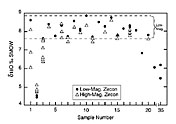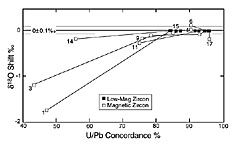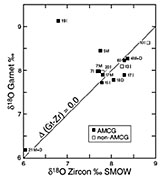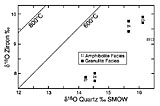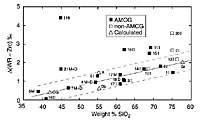Oxygen Isotope Geochemistry of Zircon
Valley, John W., Chiarenzelli, Jeffrey R., and McLelland, James M. (1994) Oxygen isotope geochemistry of zircon. Earth and Planetary Science Letters, v. 126, p. 187-206
Abstract
The high-temperature and small sample size of an I.R. laser system has allowed the first detailed study of oxygen isotope ratios in zircon. Low-magnetism zircons that have grown during metamorphism in the Adirondack Mts., N.Y. preserve primary d18O values and low-magnetism igneous zircons are likewise primary, showing no significant affect due to subsequent granulite facies metamorphism. The measured fractionation between zircon and garnet is D(GtZrc)=0.0±0.2‰(1s) for most low-magnetism zircons in meta-igneous rocks. The consistency of this value indicates equilibration at temperatures of 700-1100ºC and little or no change in the equilibrium fractionation over this temperature range. In contrast, detrital low-magnetism zircons in quartzite preserve igneous compositions, up to 4‰ out of equilibrium with host quartz, in spite of granulite facies metamorphism. The oxygen isotope composition of zircon can be linked to U-Pb ages and can ‘see though’ metamorphism, providing a new tool for deciphering complex igneous, metamorphic and hydrothermal histories. Zircons separated by magnetic susceptibility show a consistent correlation. Low-magnetism zircons have the lowest uranium contents, the most concordant U-Pb isotopic compositions, and primary d18O values. In contrast, high-magnetism zircons are up to 2‰ lower in d18O than low-magnetism zircons from the same rock. The resetting of oxygen isotope ratios in high-magnetism zircons is caused by radiation damage which creates microfractures and enhances isotopic exchange.
Zircons from the metamorphosed anorthosite-mangerite-charnockite-granite (AMCG) suite of the Adirondacks have previously been dated (1125-1157 Ma) and classified as igneous, metamorphic or disturbed based on their physical and U-Pb isotopic characteristics. Low-magnetism zircons from the AMCG suite have high, nearly constant values of d18O that average 8.1 ± 0.4‰(1s ) for samples ranging from 39 to 75 wt% SiO2. Only olivine metagabbros have lower average values (6.4‰), consistent with the hypothesis that they represent nearly pristine samples of the anorthosite’s parent magma. Whole-rock values of d18O are also high in the AMCG suite and increase with SiO2 content, as predicted for a process of assimilation and fractional crystallization. Taken together, these data suggest that the elevated values of oxygen isotope ratios result from partial melting and contamination involving metasediments in the deep crust, before the crystallization of zircon. More normal values elsewhere in the Grenville Province record deep-seated, pre 1150 Ma regional differences.
